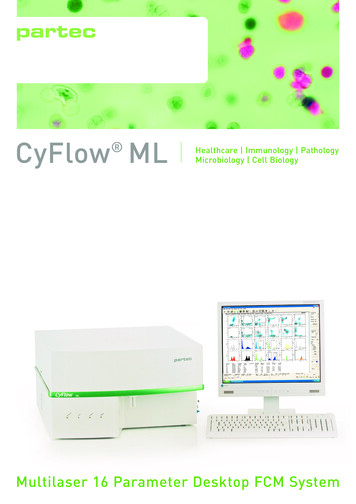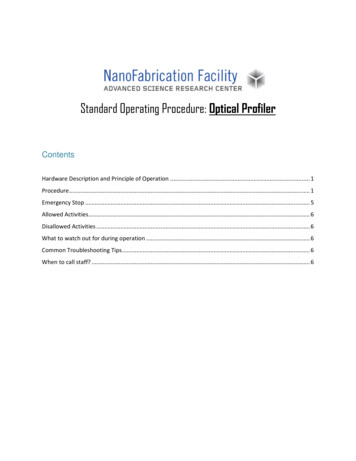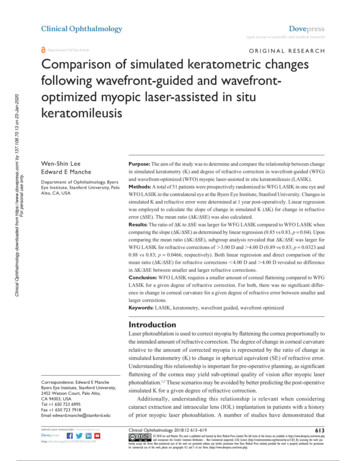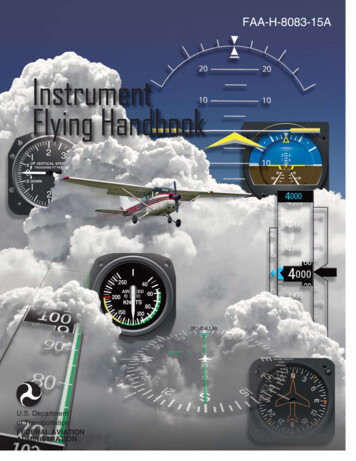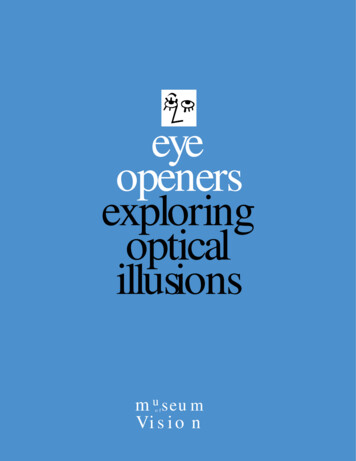
Transcription
eyeopenersexploringopticalillusionsmuseumVisionof
eyeopenersexploringopticalillusionsmuseumVisionof
T H E M I S S I O N O F T H E M U S E U M O F V I S I O N I S TOE D U C AT E P E O P L E A B O U T T H E E Y E A N D V I S I O N .The Museum has a variety of resources for people who arecurious about our most important sense—vision. A collection of over 10,000 vision-relatedobjects, dating from the 300 BC to the present Interactive public outreach programs for children Traveling ExhibitionsFor more information, contact:Museum of Vision at 415-561-8500 2000 by the Museum of VisionFoundation of the American Academy of Ophthalmology655 Beach Street, San Francisco, CA 94109-1336
EYE RCHAPTER2:3:4:HOW WE SEE; THE EYE AND THEHUMAN VISUAL SYSTEMKey ConceptsParts of the EyeHow do You See?How does the Eye Focus?ActivitiesName the PartsDraw Your EyeBINOCULAR VISIONActivitiesDifferent ViewsHole-in-Your-HandFind Your Blind SpotTHEEYE-BRAINCONNECTIONActivities7 Optical Illusions#1:Train Tracks#2: Rotating Staircase#3: Barrel#4: Kissing Lovebirds#5: Smiling Frogs#6:Two Straws#7:Two FlowersPERSISTENCEOF VISIONActivitiesMake a Spinning Disc (Thaumatrope)Make a 2728303135
INTRODUCTIONOptical illusions are pictures that play tricks onyour eyes and confuse your brain. They arean enjoyable way of learning about the science of vision as well as a playful reminderthat our assumptions about the visual worldcan sometimes be deceptive.The optical illusions in this book illustrate three fascinating aspects of thehuman visual system: binocular vision, the eye-brain connection, and persistence of vision. Can you believe your eyes? Not always.You will discover thatsome optical illusions trick us because we have two eyes (binocular vision).Others are the result of our brain remembering one thing while our eyes areseeing another (the eye-brain connection). Still other illusions happen becausewe think we still see an object after it has disappeared from view (persistenceof vision).How to use this book. The first chapter of this book is an introduction tothe eye and the human visual system. Each of the following three chaptersfocuses on binocular vision, the eye-brain connection, and persistence ofCONTINUED
CONTINUEDvision. They contain optical illusion demonstrations and activities designedto help students understand these concepts.Who is this book for? This book is designed for multiple uses, includingclassrooms, home schools, and museum programs.While some of the opticalillusions in this book can be appreciated by children of all ages, the book istargeted to students in the fourth, fifth and sixth grades.These children willbest be able to grasp the fundamental principles of vision discussed here.We hope that Eye Openers: Exploring Optical Illusions provides anenjoyable learning experience and stimulates interest in the science of vision.
6E Y E O P E N E R S F RO M T H E M U S E U M O F V I S I O NN O T ET OT H EE D U C A T O RT h i s c h a p t e r i n c l u d e s b a c k g ro u n d i n f o r m a t i o n o nt h e eye a n d t h e h u m a n v i s u a l s y s t e m . T h e a c t i v i t ys h e e t s c a n b e xe roxe d a n d h a n d e d o u t a s r e f e r e n c e s , o r t h e y c a n b e u s e d a s ove r h e a d s i n a c l a s s ro o m d i s c u s s i o n .There are many ways in which we experience andinterpret the world around us. Have you everthought what your world would be like if one ofyour five senses was lost or impaired? Consider notbeing able to smell a rose, or taste a sweet orange, orHOWWE SEETHE EYEAND THEHUMANVISUALSYSTEMhear a dog bark, or see a beautiful sunset.Our sensesfill our world with delightful sensations. Let’s take acloser look at one incredible sense: vision.Vision is a complex sense.The eyes inform acomplex visual system that makes billions of calculations every second. In fact, seventy percent of thebody’s sense receptors are found in the eyes.Important though our eyes are, there isanother critical component needed to help us see —our brain. Without it, vision would not be possiblefor us. In fact, it’s the brain that drives our visual sys-W H AT ’ S I N1THIS CHAPTER?tem. In this chapter, you will learn about the eye’sanatomy and how the human visual system works.key conceptsactivityactivityName the PartsDraw Your EyeParts of the EyeHow Do You see?How Does the Eye Focus?
E Y E O P E N E R S F RO M T H E M U S E U M O F V I S I O N7partseyekey conceptof theThe iris is the colored partof your eye. It has twomuscles that open andclose your pupil.The retina is the lining inside theback of your eye. Light-sensitivecells on the retina, called rods andcones, change light into messagesthat your brain understands.The pupil is the hole inthe middle of your iris.It changes size to letmore or less light intoyour eye.The curved cornea bendslight into your eye.It’s tough and clear like awindshield and protects youreye from dust.The optic nerve carries themessages from your retina toyour brain.The lens is clear and flexible. Itchanges shape to focus lightonto your retina.1CHAPTER ONE/HOW WE SEE
E Y E O P E N E R S F RO M T H E M U S E U M O F V I S I O Nhowsee?key conceptdo you First, light bounces off objects all around you and entersyour eye. Then the light passes through your pupil and lens to theretina at the back of your eye. In the retina, the light makes an upside-down and backwards picture. The retina contains light-sensitive cells (called rods andcones) that change the picture into messages that yourbrain understands. The optic nerve carries these messages to your brain. Finally, your brain reads the messages and tells you whatyou’re looking at.1CHAPTER ONE/HOW WE SEE8
9E Y E O P E N E R S F RO M T H E M U S E U M O F V I S I O Nhowfocus?does the eye You focus light with your cornea and lens. Your curved cornea bends light into your eye. Your lens changes shape to bring things into focus.key conceptrelaxed musclerelaxed lensdistant objectWhen you look at things that are faraway, muscles in your eye relax and yourlens looks like a slim disc.contracted muscleWhen you look atthings that are close,muscles in your eyecontract and makeyour lens thicker.thickened lensnear object1CHAPTER ONE/HOW WE SEE
E Y E O P E N E R S F RO M T H E M U S E U M O F V I S I O N10namepartstheCan you name the parts of the eye? Color and identify thedifferent parts of this eye cross section (answers on page 8).activityIrisRetinaLensPupilCorneaOptic Nerve1CHAPTER ONE/HOW WE SEE
11E Y E O P E N E R S F RO M T H E M U S E U M O F V I S I O Neye factyourDraw a picture of your eye (you might look in a mirror)and include these parts:PupilIrisEyelashesactivityWhen we ask,“What color areyour eyes?”, weare really asking,“What color areyour irises?”What color areyour’s? Whatcolor irises’ doyour friendshave?draweye1CHAPTER ONE/HOW WE SEEEyebrow
E Y E O P E N E R S F RO M T H E M U S E U M O F V I S I O N12Humans see the world with two eyes.This is calledbinocular (bi-NOC-u-lur) vision, (bi means two,ocular means eye). However, since our eyes are abouttwo inches apart, each eye sees a slightly differentview. Our brain combines the views from our twoeyes and enables us to see things in 3-D.BINOCULARVISION3-D vision helps us see depth. With 3-Dvision we know where things are in space.We canreach for a book or catch a ball.Do you have to have two eyes to see depth?It helps, but even people who see with only one eyecan sense depth.That’s because their brain picks upvisual clues from the world around them and learnshow to see 3-D.W H AT ’ S I N2THIS CHAPTER?activityactivityactivityDifferent ViewsHole-in-Your-HandFind Your Blind Spot
13E Y E O P E N E R S F RO M T H E M U S E U M O F V I S I O NdifferentviewsWRECIPEDESCRIPTIONTeacher-led demonstrationPURPOSETo show students that each eyesees a slightly different viewactivityLENGTH OFACTIVITY5 minutesMATERIALSnoneCONTINUED2CHAPTER TWO / BINOCULAR VISION
E Y E O P E N E R S F RO M T H E M U S E U M O F V I S I O Ndifferent viewsSTEPSRead the following instructions to your students:activity1.Close one eye.2. Hold one arm straight out in front of you.3. Point with your finger at something in the room — itcould be a corner where the ceiling and walls meet, or aflag, or a poster.4. Don’t move your finger!5. Now switch eyes.6. Did it look like your finger moved? That’s because eacheye sees a slightly different view.2CHAPTER TWO / BINOCULAR VISION14
15E Y E O P E N E R S F RO M T H E M U S E U M O F V I S I O ts will create an optical illusionwith an every-day object.PURPOSETo show that each eye sees a slightlydifferent view, and that the brain putsthe two views together to form oneimage.LENGTH OFACTIVITY15 minutesMATERIALS 1 cardboard tube (paper towel ortoilet paper roll works well) OR 1piece of paper per student (whichthe student will roll into a tube.)CONTINUED2CHAPTER TWO / BINOCULAR VISION
16E Y E O P E N E R S F RO M T H E M U S E U M O F V I S I O Nhole-in-your-handSTEPS Give each student a cardboard tube, or instruct the student toroll up a piece of paper and make it into a tube.eye factWhen you lookthrough the tube andsee a hole in yourhand, you are seeingan optical illusion.Youlooked through thetube into the distancewith your left eye,and you looked atyour right hand withyour right eye.Yourbrain took what yourleft eye saw and whatyour right eye sawand put them together into one picture —a hole in your hand! Read the following instructions to your students:1. Hold the tube in your left hand and place it infront of your left eye. (Look throughthe tube as though you were lookingthrough a telescope.)2. Keep both eyes open and look at anobject in the distance. (You can pickan object in the classroom forthe students to look at.)3. Hold your right hand in front ofyour face, with your palm facing you.activity4. Put the edge of your right hand (pinkie-finger side) next to ortouching the tube.5. Do you see a hole in your hand?N OT E TO T H EE D U C ATO RLeft eyesees thisI f t h e s t u d e n t s h av etrouble seeing the holei n t h e i r h a n d , h av ethem slide their righthand up or down thetube until they see it. Iftheir right hand is tooclose to their eye , theywon’t see the hole .2CHAPTER TWO / BINOCULAR VISIONYour brain putstogether whatyour left andright eyes see.Right eyesees this
17E Y E O P E N E R S F RO M T H E M U S E U M O F V I S I O Nfindblind spotyourWRECIPEDESCRIPTIONStudents will make a simple propand use it to find their blind spot.PURPOSETo show students how to find theirblind spot.activityLENGTH OFAC T I V I T Y20 minutesM AT E R I A L S One 3” x 5” index card (or otherstiff paper) per student black markers 1 ruler per studentCONTINUED2CHAPTER TWO / BINOCULAR VISION
18E Y E O P E N E R S F RO M T H E M U S E U M O F V I S I O Nfind your blind spotSTEPS1. Make a dot and an X on the index card as shown:x2. Hold the card at eye level about an arm’s length away.Make sure the X is on the RIGHT.3. Close your RIGHT eye.activity4. Look directly at the X with your LEFT eye. Notice thatyou can also see the dot.5. Focus on the X, but be aware of the dot, as you slowlybring the card towards your face. At some point the dotwill disappear, and then reappear.That’s your blind spot.6. Now close your LEFT eye and look directly at the dotwith your RIGHT eye.This time the X will disappear andreappear as you bring the card slowly toward your face.CONTINUED2CHAPTER TWO / BINOCULAR VISION
19E Y E O P E N E R S F RO M T H E M U S E U M O F V I S I O Nfind your blind spotN OW T RY T H I S(optional)1. Draw a straight line across the card, from one edge tothe other, through the center of the X and the dot.2. Do the activity again.xactivity3. Notice that when the dot disappears, the line appears tobe continuous, with no gap where the dot should be.Your brain automatically “fills in” the blind spot withwhat it thinks should be there.At the back of your eye is your retina. Your retina ismade up of light-sensitive cells which send messages toyour brain about what you see.Your blind spot is locat-eye facted at the place where your optic nerve joins yourretina. (See illustration of the eye in Chapter 1 of thisbook.) There are no light-sensitive cells in this area, sothis part of the retina can’t see. When you hold the card so the light from thedot falls on this spot, you can’t see the dot.Most of the time you don’t notice your blind spot. That’s because the blindspot from one eye doesn’t line up with the blind spot from the other eye. Eacheye supplies the missing eye’s information.And sometimes your brain fills in themissing spots with what it thinks should be there.2CHAPTER TWO / BINOCULAR VISION
E Y E O P E N E R S F RO M T H E M U S E U M O F V I S I O N20Seeing happens in the brain.Your eyes take in information from the world around you in the form of light.That information is then sent to the brain, which makessense of what your eyes are seeing. (See illustration ofthe human visual system in Chapter 1 of this book.)Sometimes your eyes see things that your braindoesn’t understand. These are optical illusions — pictures that play tricks on your eyes and confuse yourbrain. Besides being fun, optical illusions can help us toTHEEYE-BRAINCONNECTIONbetter understand vision. They demonstrate just howclosely our eyes and brain work together to help us see.Scientists have studied the phenomenon of opticalillusions and they still don’t completely understand oragree on how they work. However, many scientistsbelieve that some optical illusions fool us when theinformation taken in by our eyes conflicts with howour brain interprets that information. The brain can’t3W H AT ’ S I NTHIS CHAPTER?make sense of what the eyes are seeing, so it falls backon its previous experience. It turns the unfamiliar intosomething familiar.activities7 OPTICAL ILLUSIONS#1:Train Tracks2: Rotating Staircase#3: Barrel#4: Kissing Lovebirds#5: Smiling Frogs#6:Two Straws#7:Two Flowers#
21E Y E O P E N E R S F RO M T H E M U S E U M O F V I S I O N7 opticalillusionsWRECIPEDESCRIPTIONStudents will look at sevenoptical illusions and discuss themwith the teacher and their classmates.PURPOSETo introduce students to thephenomenon of optical illusions.activityLENGTH OFAC T I V I T Y30 minutesM AT E R I A L S 1 set of photocopied opticalillusion sheets per student(7 in each set; see masters on thepages that follow) rulers pencil or pen (optional)STEPSDistribute photocopies of the following seven opticalillusions sheets to each student. See page 29 for notes onall the optical illusions.CONTINUED3CHAPTER THREE / OPTICAL ILLUSIONS
E Y E O P E N E R S F RO M T H E M U S E U M O F V I S I O Nactivity#122train tracks What seems to be happening to the train tracks in this picture?3CHAPTER THREE / OPTICAL ILLUSIONS
E Y E O P E N E R S F RO M T H E M U S E U M O F V I S I O N#2rotatingactivitystaircase What do you see when you look at this picture? A staircaserunning from left to right or an upside-down staircase? Put the paper on the table in front of you and spin itslowly in a circle.What happens to the staircase?3CHAPTER THREE / OPTICAL ILLUSIONS23
E Y E O P E N E R S F RO M T H E M U S E U M O F V I S I O Nactivity#3barrel What do you see when you look at this picture? Do you see eleven separate bars or one continuous line? Trace the line with a pencil or your finger. What did you discover?3CHAPTER THREE / OPTICAL ILLUSIONS24
E Y E O P E N E R S F RO M T H E M U S E U M O F V I S I O N#4kissingactivitylovebirds Hold the drawing of the lovebirds at arm’s length.Stare at the blank spot between the lovebirds’ beaks.Slowly bring the paper closer to your face.Do you see the two birds kissing?3CHAPTER THREE / OPTICAL ILLUSIONS25
E Y E O P E N E R S F RO M T H E M U S E U M O F V I S I O N#5smilingfrogsactivityOPIECLEO Which frog has the longest mouth, Opie or Cleo? Measure each smile with a ruler. What did you discover?3CHAPTER THREE / OPTICAL ILLUSIONS26
E Y E O P E N E R S F RO M T H E M U S E U M O F V I S I O Nactivity#6twostraws Hold the drawing of two straws at arm’s length. Are the straws straight or crooked? (Most people seecrooked straws.) Lay the ruler along the length of the straw — is the strawstraight or crooked? Now hold the drawing flat, like a tray, and put it rightunder your nose. How do the straws look now? (The straws should appearstraight.)3CHAPTER THREE / OPTICAL ILLUSIONS27
E Y E O P E N E R S F RO M T H E M U S E U M O F V I S I O Nactivity#7twoflowers Look closely at the two clusters of circles. Now look at the two middle circles. Which one is bigger? Measure across the middle (the diameter) of each circle. What did you discover?3CHAPTER THREE / OPTICAL ILLUSIONS28
E Y E O P E N E R S F RO M T H E M U S E U M O F V I S I O NOPTICALILLUSIONNOTES1. TRAIN TRACKSThe train tracks appear to come together in the distance. In reality,they don’t come together. Although our eyes tell us that the traintracks are converging, our brain knows that they’re parallel, andthat parallel lines never converge.2 . R OTAT I N GS TA I R C A S EThe staircase seems to flip around as the paper is turned.You cansee the staircase two different ways, but you can only see it oneway at a time.3. BARRELYour brain sometimes sees eight separate bars, and other times seesone continuous line when you look at this picture.4. KISSINGLOVEBIRDSAs you bring the drawing closer to your face, the birds’ beaksappear to get closer and closer together, until finally, just in frontof your nose, they appear to be touching.5. SMILINGFROGSBoth mouths are the same size. Cleo’s mouth seems bigger becauseour eyes follow the lines going away from the mouth at either end.Opie’s mouth seems to be smaller because the lines at either enddirect our eyes towards the center of the mouth.6. TWOSTRAWSPatterns can make straight objects appear crooked.7. TWOFLOWERSBoth circles are the same size. The surrounding circles make thecircles seem to be different sizes. When the inner circle issurrounded by smaller circles, it seems large.When the inner circleis surrounded by larger circles, it seems small.3CHAPTER THREE / OPTICAL ILLUSIONS29
30E Y E O P E N E R S F RO M T H E M U S E U M O F V I S I O NPersistence of vision is the eye’s ability to keep seeing an image of an object for a fraction of a secondafter the object has disappeared from view. Theimage of an object stays on your retina even afteryou’ve stopped looking at it. Your eye and brainactually retain a visual impression for about 1/30thof a second.The principle of persistence of vision is used inPERSISTENCEOF VISIONmaking motion pictures and animated cartoons.Movies are made up of a series of separate pictures,flashed on the screen at a speed of 24 per second.When you’re watching a movie, each image lingerson the retina long enough to merge with the nextimage, and you have the illusion of motion (hencethe name: motion pictures.) You don’t even noticethat the movie screen is dark half the time!In this section, you will make two motion toysW H AT ’ S I N4THIS CHAPTER?that will demonstrate the principle of persistenceof vision.activityactivityMake a Spinning Disc(Thaumatrope)Make a Flipbook
31E Y E O P E N E R S F RO M T H E M U S E U M O F V I S I O Nmake disceye facta spinningSpinning discs, orthaumatropes(tho-ma-tropes), areone of the earliestmotion toys.Theywere invented in 1827by Dr. J.A. Paris.Thename thaumatropecomes from theGreek, and means“wonder turner.”WRECIPEThaumatropes workaccording to the principle of persistence ofvision.When you spinthe thaumatrope,the two separatedrawings on oppositeside of the same disc,seem to blend intoone image.DESCRIPTIONStudents will learn about persistence ofvision by making a spinning disc orthaumatrope — an early motion toy.PURPOSETo introduce students to persistenceof vision.activityLENGTH OFAC T I V I T Y45 minutesP R E PA R AT I O N20 minutesTIME FORI N S T RU C TO RInstructor should make a spinning discor thaumatrope in advance to use in ademonstration for the students.M AT E R I A L S index cards or heavy stock paper compass, drinking glass or templatefor approximately 3” diameter circle 2 pieces of string per student, eachabout 15” long hole punch scissors pencils crayons, markers, colored pencils thaumatrope for demonstrationCONTINUED4CHAPTER FOUR / PERSISTENCE OF VISION
32E Y E O P E N E R S F RO M T H E M U S E U M O F V I S I O Nmake a spinning discPRE-ACTIVITY STEPSFORINSTRUCTORStudents will have a clearer understanding of this activity if youprepare a sample spinning disc or thaumatrope in advance.activity1. Xerox the thaumatrope master found on page 34.2. Cut out the two circles and glue them on two differentsides of an index card or piece of card stock. Be surethat one image is right-side-up and the other is upside-down or the trick won’t work.3. Cut out the circles.4. Cut two pieces of string about 15” long.5. Punch a hole in either side of the card.6. Tie a string through each hole.7. Wrap the string around each hand (see illustration).8. Wind the toy up by flipping the disc over and over,making twists in the strings.9. Pull the strings to make the toy spin.CONTINUED4CHAPTER FOUR / PERSISTENCE OF VISION
E Y E O P E N E R S F RO M T H E M U S E U M O F V I S I O Nmake a spinning discSTEPSFOReye factHave the students:1. Use a compass or drinking glass or circle template tocut out a circle 3” to 5” in diameter from an index cardor card stock.2. Draw the two images in pencil first on opposite sides oftheir cut-out circle. (Remember that one should beright-side-up and the other up-side-down.)3. Color in the images.4. Punch a hole in either side of the circular card.5. Run a string through each hole and tie each piece ofstring in a loop.6. Put their hands through the loops of string.7. Wind the toy up by flipping it over and over, makingtwists in the strings.8. Pull the strings to make the toy spin.activityWhen things movevery quickly beforeyour eyes, it’sdifficult for yourbrain to keep eachpicture separate.Your brain actuallycontinues to seeone picture for avery brief momenteven after the dischas flipped to theother side.This iscalled persistence ofvision meaning thatthe image persists,or continues to beseen, for a splitsecond even afterit’s actually outof sight.STUDENTSD E M O N S T R AT I O NFORSTUDENTS1. Show the students the thaumatrope you've made.2. Discuss with them the concept of persistence of visionand how the thaumatrope works.3. Have the students try the thaumatrope.4. Brainstorm ideas for possible thaumatropes with thestudents. (Examples include a frog on a lily pad, a fishin the water, a bird in a nest.)4CHAPTER FOUR / PERSISTENCE OF VISION33
E Y E O P E N E R S F RO M T H E M U S E U M O F V I S I O NactivityT H A U M AT R O P E4CHAPTER FOUR / PERSISTENCE OF VISIONMASTER34
35E Y E O P E N E R S F RO M T H E M U S E U M O F V I S I O NmakeaflipbookWactivityRECIPEDESCRIPTIONStudents will learn about persistenceof vision by creating a flip book.PURPOSETo demonstrate the role of persistence of vision in animation.P R E PA R AT I O NTIME FOR20 minutesI N S T RU C TO REducator should make a flipbook inadvance to use in a demonstration forthe students.LENGTH OFAC T I V I T Y40 minutesM AT E R I A L S approximately 20 3”x 4” pieces ofpaper per student (enough forstudents to have spares if theymake mistakes) scissors stapler markers, crayons, colored pencilsCONTINUED4CHAPTER FOUR / PERSISTENCE OF VISION
36E Y E O P E N E R S F RO M T H E M U S E U M O F V I S I O Nmake a flipbookPRE-ACTIVITY STEPSFORINSTRUCTORStudents will have a clearer understanding of this activity if youprepare a sample flipbook in advance.eye factMovies andcartoons work thesame way as aflipbook. A movieprojector flashesone still pictureafter another veryquickly onto thescreen.Your brainblends one pictureinto the next one,giving you theillusion ofmovement. Create a demonstration flipbook1. Photocopy the “Moon Blink” flipbook master found inthis chapter.2. Cut out each image.3. Staple each image together at the left-hand margin. Prepare flip book pages for classroom activity. STAPLE HERE activity1. Cut paper into approximately 3”x 4” pieces for classroomactivity (approximately 20 pieces of paper per student)STAPLE HERECONTINUED4CHAPTER FOUR / PERSISTENCE OF VISION
E Y E O P E N E R S F RO M T H E M U S E U M O F V I S I O Nmake a flipbookSTEPSD E M O N S T R AT I O NFORSTUDENTS1. Using the flipbook that you made from the master inthis activity book, demonstrate how a flipbook works.2. Discuss with students the concept of persistence ofvision, and how the flipbook works.3. Tell them they are going to make their own flipbooks.Explain that to make a flipbook they’ll have to make aseries of pictures, each slightly different from the next.4. Brainstorm ideas for flipbooks (examples: a bouncingball, stick figure doing jumping jacks, a person openingand closing their eyes, a bird flapping its wings.)activityFLIPBOOK ACTIVITYFORSTUDENTSHave the students:1. Select about 20 sheets of pre-cut paper.2. Draw their pictures. Remind them to draw the picturenearer the right-hand side of the paper as the staple willgo at the left margin.3. Put the pictures in order.4. Staple the pictures at the left margin.5. Flip through the pages and see the animation.A LT E R N AT E A C T I V I T Y Photocopy the Moon Blink master for each student andhave the students assemble a Moon Blink flipbook.Students can also color in the images.4CHAPTER FOUR / PERSISTENCE OF VISION37
1234
5678
9101112
13141516
17181920
21222324
25262728
29303132
33343536
37383940
41424344
45464748
49505152
53545556
57585960
61626364
65666768
BIBLIOGRAPHYBlock, J. Richard and Harold Yuker. Can You BelieveYour Eyes? New York: Bruner/MazelPublishers, 1992.Churchill, E. Richard. How to Make Optical Illusions.New York: Sterling Publishing Co., Inc., 1989.Crystal, Nancy and Milan Tytla. You Won’t Believe YourEyes! Toronto: Annick Press, Ltd., 1992.DiSpezio, Michael. Visual Foolery. Reading, MA:Addison-Wesley Publishing Company, 1995.Paraquin, Charles H. The World’s Best Optical Illusions.New York: Sterling Publishing Co., Inc., 1987.Simon, Seymour. The Optical Illusion Book. New York:William Morrow & Company, 1976.Wood, Robert W. Physics for Students: 49 EasyExperiments with Optics. Blue Ridge Sumit,PA:TAB Books, 1990.Web Sites The Exploratorium Science Snacks have a number ofactivities about vision and optical illusions:http://www.exploratorium.edu/snacks
You have been exploring youreyes and vision.The worldwe experience around us is arich mixture of all of our fivesenses.Take a moment tofocus and think about yourother senses.What are you hearing? Areyou cold or warm? Breathedeeply, what can you smell?Do you taste anything? Whatare you seeing? Close youreyes and answer thesequestions.Museum of VisionFoundation of the American Academy of Ophthalmology655 Beach Street, San Francisco, CA 94109-1336415-561-8500
ptical illusions are pictures that play tricks on your eyes and confuse your brain.They are an enjoyable way of learning about the sci-ence of vision as well as a playful reminder that our assumptions about the visual world can sometimes be deceptive. The optical illusions in this book illustrate three fascinating aspects of theFile Size: 2MB



